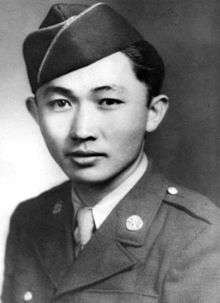Kiyoshi K. Muranaga
Kiyoshi K. Muranaga (February 16, 1922 – June 26, 1944) was a United States Army soldier and a recipient of the United States military's highest decoration—the Medal of Honor—for his actions in World War II.[1]
Kiyoshi K. Muranaga | |
|---|---|
 Kiyoshi K. Muranaga, Medal of Honor recipient | |
| Born | February 16, 1922 Los Angeles, California |
| Died | June 26, 1944 (aged 22) near Suvereto, Italy † |
| Place of burial | |
| Allegiance | |
| Service/ | |
| Years of service | 1943–1944 |
| Rank | |
| Unit | 442nd Regimental Combat Team |
| Battles/wars | World War II |
| Awards | |
Early life
Muranaga was born in California to Japanese immigrant parents. He is a Nisei, which means that he is a second generation Japanese-American. He was raised as one of the oldest of 9 other siblings in what is now Gardena, California.
He was interned with his family at the Granada War Relocation Center in Colorado.[2]
Soldier
Muranaga joined the US Army in May 1943.[3]
Muranaga volunteered to be part of the all-Nisei 442nd Regimental Combat Team.[4] This army unit was mostly made up of Japanese Americans from Hawaii and the mainland. [5] Muranaga was killed on the first day of action for the 442nd in Italy.[6]
For his actions in June 1944, he was posthumously awarded the Army's second-highest decoration, the Distinguished Service Cross.[7] A 1990s review of service records for Asian Americans who received the Distinguished Service Cross during World War II led to Muranaga's award being upgraded to the Medal of Honor. In a ceremony at the White House on June 21, 2000, his surviving family was presented with his Medal of Honor by President Bill Clinton. Twenty-one other Asian Americans also received the medal during the ceremony, all but seven of them posthumously.
Muranaga, aged 22 at his death, was buried in Evergreen Cemetery, Los Angeles, California.
Muranaga's brothers were also soldiers. Kenichi (1924–2009)[8] and Yoshio (1923–2008)[9] also were in the 442nd. The youngest brother Tomi (born 1935)[10] was a soldier in Korea.
Medal of Honor citation
Muranaga's Medal of Honor recognized his conduct in frontline fighting in central Italy in 1944.[1]
On June 26, 1944, Muranaga was serving as a private first class in the 442nd Regimental Combat Team. On that day, near Suvereto, Italy, he single-handedly manned his squad's mortar weapon in an attempt to destroy an enemy artillery gun. Muranaga was able to fire three shells before being killed by the enemy's return fire.
Private First Class Muranaga's official Medal of Honor citation reads:

Private First Class Kiyoshi K. Muranaga distinguished himself by extraordinary heroism in action on 26 June 1944, near Suvereto, Italy. Private First Class Muranaga's company encountered a strong enemy force in commanding positions and with superior firepower. An enemy 88mm self-propelled gun opened direct fire on the company, causing the men to disperse and seek cover. Private First Class Muranaga's mortar squad was ordered to action, but the terrain made it impossible to set up their weapons. The squad leader, realizing the vulnerability of the mortar position, moved his men away from the gun to positions of relative safety. Because of the heavy casualties being inflicted on his company, Private First Class Muranaga, who served as a gunner, attempted to neutralize the 88mm weapon alone. Voluntarily remaining at his gun position, Private First Class Muranaga manned the mortar himself and opened fire on the enemy gun at a range of approximately 400 yards. With his third round, he was able to correct his fire so that the shell landed directly in front of the enemy gun. Meanwhile, the enemy crew, immediately aware of the source of mortar fire, turned their 88mm weapon directly on Private First Class Muranaga's position. Before Private First Class Muranaga could fire a fourth round, an 88mm shell scored a direct hit on his position, killing him instantly. Because of the accuracy of Private First Class Muranaga's previous fire, the enemy soldiers decided not to risk further exposure and immediately abandoned their position. Private First Class Muranaga's extraordinary heroism and devotion to duty are in keeping with the highest traditions of military service and reflect great credit on him, his unit, and the United States Army.[11]
See also
- List of Asian American Medal of Honor recipients
- List of Medal of Honor recipients for World War II
References
- US Army Center of Military History, "Medal of Honor Recipients, World War II (M-S)"; retrieved 2012-12-7.
- 442nd Regimental Combat Team, "Tributes," Men of F Company, 2nd Battalion, Kiyoshi Muranaga; retrieved 2012-12-7.
- U.S. National Archives and Records Administration (NARA), WWII Army Enlistment Record #37356488 (Muranaga, Kiyoshi K.); retrieved 2012-12-7.
- Go for Broke National Education Center, "Medal of Honor Recipient Private First Class Kiyoshi K. Muranaga" Archived 2011-02-03 at the Wayback Machine; retrieved 2012-12-7.
- "100th Battalion, 442nd Infantry" at Global Security.org; retrieved 2012-12-7.
- Discover Nikkei, "Kiyoshi K. Muranaga (KIA 06/26/1944)"; Hawaii Nisei Story, First Experience of War," First Battle; retrieved 2012-12-7.
- "21 Asian American World War II Vets to Get Medal of Honor" at University of Hawaii Digital History Archived 2012-03-17 at the Wayback Machine; retrieved 2012-12-7.
- NARA, WWII Army Enlistment Record #37362102 (Muranaga, Kenichi K.)
- NARA, WWII Army Enlistment Record #37715182 (Muranaga, Yoshi K.)
- "Japanese American Internee Data File: Tomi Muranaga". National Archives and Records Administration. Retrieved September 2, 2019.
- Gomez-Granger, Julissa. (2008). Medal of Honor Recipients: 1979-2008, "Muranga, Kiyoshi," pp. 13-14 [PDF 17-18 of 44]; retrieved 2012-12-7.